
Abandoned & Little-Known Airfields:
California: Eastern Riverside County
© 2002, © 2016 by Paul Freeman. Revised 12/3/16.
This site covers airfields in all 50 states: Click here for the site's main menu.
____________________________________________________
Please consider a financial contribution to support the continued growth & operation of this site.
(Original) Desert Center Airport (revised 11/5/15) - Eagle Mountain Airfield / Metropolitan Water District Airstrip (revised 11/5/15)
Eagle Mountain Pumping Station Airfield (revised 11/5/15) - Gary Field / W R Byron Airport (revised 7/16/16)
Harvey's Airport / Skyway Airport (revised 11/5/15) - Heron Airport (revised 12/3/16) - Midland Airfield (revised 9/1/16)
____________________________________________________
Harvey's Airport / Skyway Airport, Blythe, CA
33.61, -114.83 (West of Blythe Airport, CA)

A 7/16/43 aerial view looking north at Harvey Airport from the 1945 AAF Airfield Directory (courtesy of Scott Murdock, enhanced by Bill Grasha).
According to Francis Blake, this small general aviation airport west of Blythe began operation in 1942 to early 1950s.
The earliest photo which has been located of Harvey Airport
was a 7/16/43 aerial view looking north from the 1945 AAF Airfield Directory (courtesy of Scott Murdock).
It depicted Harvey as having 1 unpaved northeast/southwest runway,
with possibly a gathering of small aircraft parked on the south side.
Francis Blake remarked, “I sure wonder why Harvey even bothered because Blythe had Gary Field & Heron Airport.
But Harvey's was certainly convenient to Highway 60, the main east/west road of the region.
He couldn't go any farther west since civilian aircraft (except airliners) were forbidden within 150 miles of the west coast.
And poor future planning about the Blythe Army Air Base becoming a civilian airport post-war.”
The 1945 AAF Airfield Directory (courtesy of Scott Murdock) described Harvey Airport
as a 160 acre rectangular property having 2 bare runways, measuring 2,300' northeast/southwest & 1,500' northwest/southeast.
The field was said to have 3 wood hangars, the largest measuring 40' x 30',
and to be owned & operated by private interests.

The earliest aeronautical chart depiction which has been located of Harvey Airport
was on the August 1945 San Diego Sectional Aeronautical Chart (courtesy of Chris Kennedy).
It depicted Harvey as a commercial/municipal airport.
According to “Events in the Palo Verde Valley in 1945” in the 4/14/11 Palo Verde Valley Times (courtesy of Francis Blake),
“Harvey's Airport, a civilian flying field 14 miles west of Blythe on U.S. Highway 60-70,
has been sold by its original developer, Harvey Reynolds of Covina & Blythe, to Mr. & Mrs. Edward Heard of this city.
The Heards have been operating the field for the past 2 years.
The property consists of 100 acres of land adjacent to the highway, 2 landing strips, hangars, a control tower, service station, store building & lesser structures.
The field has been used for student instruction & general civilian flying.
The Heards plan extensive expansions & improvements as soon as wartime building restrictions are lifted. The price paid was not divulged.”

A 1951 map of Riverside County (courtesy of Francis Blake)
depicted Harvey's Airport as a small rectangular outline squeezed between Route 60/70 & McCoy Mountain.
Harvey's Airport was not depicted at all on the 1952 USGS topo map.

Harvey Airport was evidently renamed at some point between 1951-54 (presumably after it was sold),
as the 1954 USGS topo map labeled it as Skyway Airport.

The only aeronautical chart depiction which has been located of Skyway Airport was on the 1955 San Diego Sectional Chart,
which depicted Skyway as having an 1,800' unpaved runway.
Skyway Airport was evidently closed at some point between 1955-65,
as it was no longer depicted on the August 1965 San Diego Sectional Aeronautical Chart (courtesy of Ron Kunse).
Skyway Airport was still depicted on the 1965 USGS topo map,
but was no longer depicted on the 1983 USGS topo map.

A 2014 aerial view (enhanced by Bill Grasha) looking northeast shows the Harvey/Skyway runway remarkably remains intact & recognizable.
The site of Harvey's Airport is located on the north side of Interstate 10, 7 miles west of Blythe Airport.
Thanks to Francis Blake for pointing out this airfield.
____________________________________________________
Eagle Mountain Pumping Station Airfield, Eagle Mountain, CA
33.8, -115.45 (East of Los Angeles, CA)

Eagle Mountain Pumping Station Airfield, as depicted on the 1987 USGS topo map.
Photo of the airport while open has not been located.
Not much is known about this airfield, including its name, date of construction, or purpose.
The adjacent Eagle Mountain Pumping Station is part of the Metropolitan Water District,
and appears on topo maps as far back as 1956.
The Eagle Mountain Pumping Station Airfield was evidently established at some point between 1972-87,
as it was not yet depicted on the 1972 USGS topo map.
The earliest depiction of Eagle Mountain Pumping Station Airfield which has been located was on the 1987 USGS topo map,
which depicted a single northwest/southeast runway, labeled simply as “Landing Strip”.

The earliest photo which has been located of the Eagle Mountain Pumping Station Airfield was a 5/20/94 USGS aerial view looking southwest.
It depicted the field as having a single paved runway marked with an “R” (denoting a private field) on the northwest end.
There did not appear to be any buildings or other improvements at the airfield.

A 5/27/12 aerial view looking southwest showed the Eagle Mountain Pumping Station runway to remain intact though deteriorated.
As of 2014, the Los Angeles Sectional Chart does not depict any airfield at this location, not even an abandoned airfield.

A 10/31/15 photo by Kurtis Clark looking north along the Eagle Mountain Pumping Station runway.
Kurtis reported, “The runway is not in bad shape, except for the piles of asphalt near the north end.”

A 10/31/15 photo by Kurtis Clark looking south along the Eagle Mountain Pumping Station runway.

A 10/31/15 photo by Kurtis Clark of the aircraft parking chains which remain at the Eagle Mountain Pumping Station Airfield.
Kurtis reported, “There was a taxiway leading all the way to the pump house, complete with a tie-down area with 3 chains.”

A 10/31/15 photo by Kurtis Clark of the “Aircraft Only” sign which remains at the Eagle Mountain Pumping Station Airfield.
Eagle Mountain Pumping Station Airfield is located southwest of the intersection of Eagle Mountain Road & Power Line Road.
____________________________________________________
Eagle Mountain Airfield / Metropolitan Water District Airstrip, Eagle Mountain, CA
33.84, -115.46 (East of Los Angeles, CA)

Eagle Mountain Airfield, as depicted on the 1987 USGS topo map.
Photo of the airport while open has not been located.
Not much is known about this airfield, including its name, date of construction, or purpose.
The town of Eagle Mountain was founded in 1948 by industrialist & tycoon Henry Kaiser, to support his adjacent Eagle Mountain iron mine.
As the mine expanded, Eagle Mountain grew to a peak population of 4,000.
It had wide, landscaped streets lined with over 400 homes, some with as many as 4 bedrooms.
Anotehr 200 trailer spaces & several boarding houses & dormitories provided living space for Kaiser's itinerant workforce.
Other amenities included an auditorium, a park, a shopping center, a community swimming pool, lighted tennis courts, a baseball diamond,
bowling alley, 2 gas stations, 8 churches and 3 schools.
Increased environmental concerns in the 1970s led to a reduction in iron output & a drop in population to a low of 1,890.
In the summer of 1980 the mine shut down briefly, reopening later that year with a reduced workforce.
On 11/3/81 Kaiser Corporation announced the phasing out of the Eagle Mountain Mine operation over several years.
The Eagle Mountain Airfield was evidently established at some point between 1972-87,
as it was not yet depicted on the 1972 USGS topo map.
The earliest depiction of Eagle Mountain Airfield which has been located was on the 1987 USGS topo map,
which depicted a single 3,200' unpaved northwest/southeast runway, labeled simply as “Landing Strip”.
Eagle Mountain experienced a resurgence in 1986 when the California Department of Corrections
proposed placing a unique privately operated prison for low-risk inmates in the town.
The shopping center was converted by 1988 into the Eagle Mountain Community Correctional Facility,
which operated until state budget problems & a fatal riot led to the closing of the prison in December 2003.
Starting in 1988 a long-running effort began to turn the gigantic open-pit mine into a massive, high-tech sanitary landfill.
According to Wikimapia, this airfield is named the Metropolitan Water District Airstrip
and was granted under a fee right-of-way in 1990.

A 5/20/94 USGS aerial view looking southeast depicted Eagle Mountain as having a single paved runway with a small paved ramp at the northwest end.
The runway was marked with a single “R” (denoting a private field) on the northwest end.
There did not appear to be any buildings at the airfield.
As of 2009, the project to turn the Eagle Mountain mine into a landfill had not yet begun.
According to a 2008 report by the Eagle Crest Energy Company, the Eagle Mountain Airfield was owned by Kaiser Industries.

A 5/27/12 aerial view looking southeast showed the Eagle Mountain runway to have been newly repaved,
although an “X” replaced the “R” previously painted on the northwest runway end.
But there was still no sign of any recent aviation usage, nor any other improvements.
As of 2014, the Los Angeles Sectional Chart does not depict any airfield at this location, not even an abandoned airfield.

A 10/31/15 photo by Kurtis Clark looking north along the Eagle Mountain runway.
Kurtis reported, “I spoke with the Metropolitan Water District.
These runways are theirs & are used to transport inspection crews to the pumping plants, and to take water samples to the lab in a timely manner.
A typical aircraft used would be a Beechcraft King Air. There are visible skid marks on the runway. It is in great shape.”

A 10/31/15 photo by Kurtis Clark looking northeast at Eagle Mountain Airfield's runway lights.

A 10/31/15 photo by Kurtis Clark of the Kaiser sign adjacent to the Eagle Mountain Airfield.
Eagle Mountain Airfield is located southeast of the intersection of Kaiser Road & Yucca Road.
Thanks to Khadijah for pointing out this airfield.
____________________________________________________
33.85, -114.8 (East of Los Angeles, CA)

Midland Airfield, as depicted on the March 1952 San Diego Sectional Aeronautical Chart (courtesy of Chris Kennedy).
Photo of the airport while open has not been located.
According to Wikipedia, Midland was a company town established in 1925, owned by the U.S. Gypsum Company.
The company harvested vast amounts of gypsum found in the area, and the town had a population of approximately 1,000 at its peak.
Many winter scenes in Hollywood films during the 20th century utilized faux snow that originated from Midland.
The Midland Airfield was evidently established at some point between 1945-52,
as it was not yet depicted on the 1945 USGS topo map.
The earliest depiction of Midland Airfield which has been located
was on the March 1952 San Diego Sectional Aeronautical Chart (courtesy of Chris Kennedy).
It depicted Midland having an 1,800' runway.
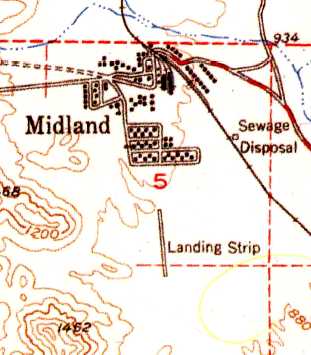
The 1952 USGS topo map depicted Midland Airport as having a single north/south runway, labeled simply as “Landing Strip”.
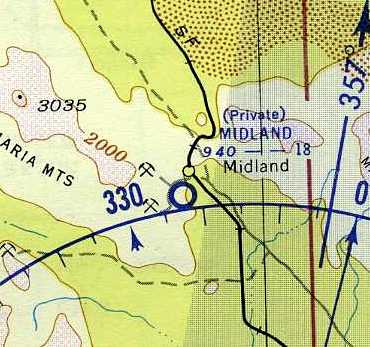
The March 1955 San Diego Sectional Aeronautical Chart (courtesy of Chris Kennedy)
depicted Midland as a private field having an 1,800' unpaved runway.
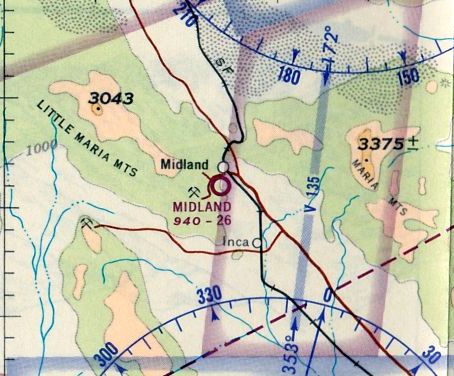
The last aeronautical chart depiction which has been located of Midland Airfield was on the August 1965 San Diego Sectional Aeronautical Chart (courtesy of Ron Kunse).
It depicted Midland as a public-use airport having a 2,600' unpaved runway.
According to Wikipedia, “As the character of the gypsum found in the area was considered too heavy as the years went on,
company activity in Midland subsided & then ended in 1966.”
A majority of the buildings of Midland were torn down by the company, leaving only foundations.

Midland Airfield had evidently gained a longer northwest/southeast runway at some point between 1955-81,
as the 1981 USGS topo map depicted the field as having 2 runways, labeled simply as “Landing Field”.
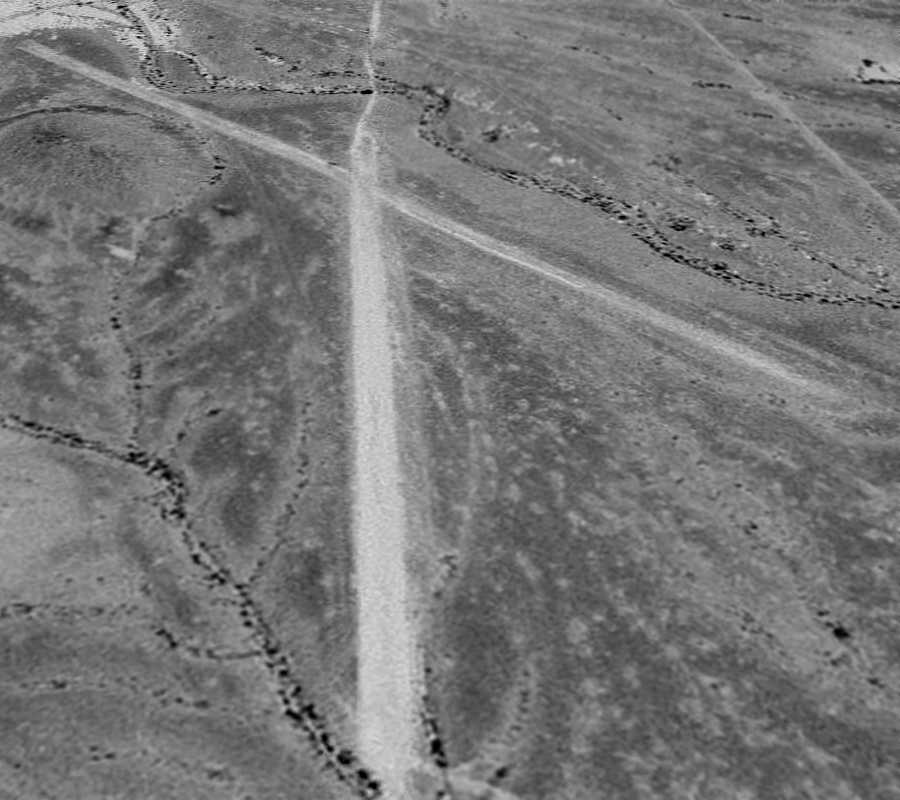
The earliest photo which has been located of Midland Airfield was a 6/15/96 USGS aerial view looking north, which depicted Midland as having 2 unpaved runways.
There was no sign of the airfield having had any buildings.

The last photo which has been located of Midland Airfield was a 6/18/10 aerial view looking north, which depicted Midland as having 2 unpaved runways.
The site of Midland Airfield is located at the southern terminus of Midland Depot Road.
Thanks to Gary Alexander for pointing out this airfield.
____________________________________________________
33.61, -114.57 (North of Yuma, AZ)

Heron Airport, as depicted on the August 1945 San Diego Sectional Aeronautical Chart (courtesy of Chris Kennedy).
Heron Airport was apparently the pre-WW2 civil airport for the town of Blythe.
Its date of construction is unknown.
The Standard Oil Company's 1929 "Airplane Landing Fields of the Pacific West" (courtesy of Chris Kennedy)
described a "Blythe Municipal" Airport as being located 3/4 mile east of Blythe, which would correspond to the location eventually occupied by Heron Airport.
It had a 3,000' loamy soil runway, oriented southwest/northeast.
The 1944 US Army/Navy Directory of Airfields (courtesy of Ken Mercer) described Heron Airport as having a 2,700' runway.
The earliest depiction of Heron Airport which has been located was on the August 1945 San Diego Sectional Aeronautical Chart (courtesy of Chris Kennedy).
It depicted Heron as a commercial/municipal airport.
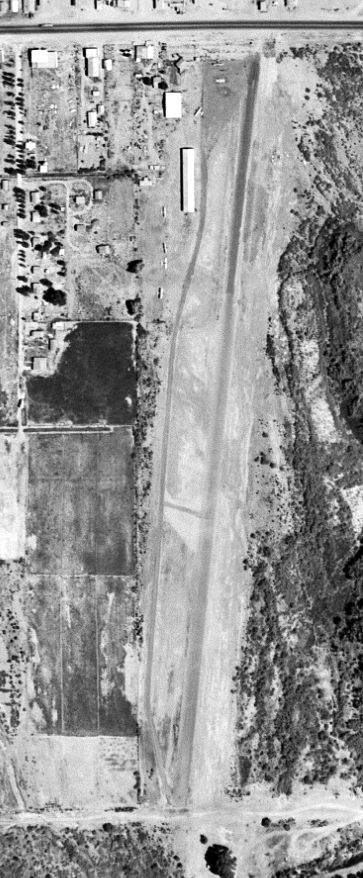
The only photo which has been located showing Heron Airport in operation was a 6/11/48 USGS aerial view.
It depicted Heron Airport as having a single north/south runway, with several small buildings & 6 single-engine aircraft on the northwest side.
Heron Airport was described on the 1949 Gila River World Aeronautical Chart (courtesy of Donald Felton) as having a 2,600' unpaved runway.

The most precise location of Heron Airport which has been located was on the 1951 USGS topo map,
which depicted “Heron Air Field” as having a single north/south runway, with several small buildings on the northwest side.

A 1954 AAA map of Riverside County (courtesy of Chris Kennedy)
depicted “Heron Field” as a square parcel of land, west of Intake Boulevard & north of 14th Avenue.
Fred Grande recalled, “I flew out of Heron field in a J3 Cub - I think it was 1953 -
taking a plane from there to an old dirt strip that the crop dusters used on the west side of the Valley.”
The runway at Heron was apparently paved at some point between 1949-55,
as the "Aerodromes" table on the 1955 San Diego Sectional Aeronautical Chart (courtesy of John Voss)
described the field as having a single 2,550' bituminous runway.
In the 1962 AOPA Airport Directory, Heron Airport was described as having a single 2,550' bare Runway 18/36,
and the operator was listed as Leon Coromes.

The August 1967 San Diego Sectional Chart (courtesy of Chris Kennedy) depicted Heron Airport as having a single 2,500' north/south paved runway.
The NTSB report for a 4/16/67 accident in which a Luscombe 8A ended up substantially damaged after performing a ground loop at Heron Airport
described the field as having a 25' wide oiled runway.

The last authoritative depiction of Heron Airport as an active airfield which has been located was in the 1968 Flight Guide (courtesy of Chris Kennedy).
It depicted Heron as having a single 2,545' paved Runway 17/35.
A parallel taxiway on the west side ran to a ramp on the northwest corner of the field, around which were clustered several small buildings.

Heron Airport was still depicted on the 1969 USGS topo map.
Raymond Mendoza recalled, “Heron Airport closed when I-10 was built through Blythe, this would be about 1969-1970.
I was born in 1965 in Blythe, and remember the freeway construction going on around the time I was 4-5 years old.
I do remember the runway being paved, and what was left on the south side of I-10 was used for storing hay much of the time.
The part on the north side of the freeway was never used for anything. The hangar became an automotive repair place.”
Heron Airport was no longer depicted at all on the 1975 USGS topo map.
The 1975 map showed that Interstate 10 had been constructed through the center of the former airport.
The 2002 USGS aerial photo showed that the site of the former Heron Airport had been bisected by Interstate 10.
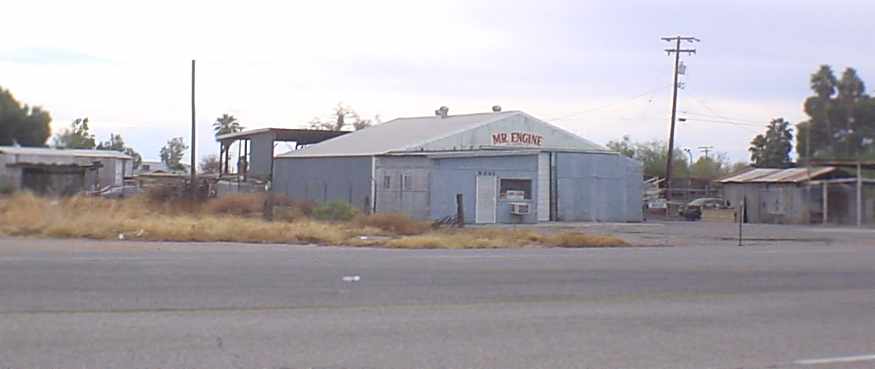
A 2006 photo by Raymond Mendoza, looking south from Hobson Way at what appears to be a former Heron Airport hangar, on the northwest corner of the site.
Raymond reported, “The hangar appears to still be in use.”

A 2014 aerial view looking southeast at the site of Heron Airport showed that the outline of the former Runway 17/35 was still visible both north & south of Interstate 10.
The former hangars are visible at bottom-left.
The Heron Airport site is located west of the intersection of Interstate 10 & Intake Boulevard.
____________________________________________________
Gary Field / W R Byron Airport (44CA), Blythe, CA
33.68, -114.64 (North of Yuma, AZ)

A 1942 photo of 2 unidentified Army civilian flight instructors in front of a Piper Cub at Gary Field.
Gary Field was the site of the Morton Air Academy,
which provided contract primary flight training to the Army Air Corps during WW2.
The date of construction of Gary Field is unknown.
However, a 1944 class book from the Morton Air Academy (courtesy of Bob Alvis)
indicated that the first official training flight from Morton Air Academy took place on 6/30/42,
piloted by Aviation Cadet Gornik & Instructor Villagren.
The earliest photo which has been located of Gary Field
was a 1942 photo of 2 unidentified Army civilian flight instructors in front of a Piper Cub.

A 7/16/43 aerial view looking north at Gary Field from the 1945 AAF Airfield Directory (courtesy of Scott Murdock).
In the school's first 2 years over 265,000 hours had been flown,
and 3,750,000 gallons of gasoline were consumed by the school's Ryan & Stearman training planes.

A WW2-era aerial view of Gary Field,
from the cover of a 1944 class book from the Morton Air Academy (courtesy of Bob Alvis, enhanced by Bill Grasha).

A view looking north along the landing mat at Gary Field,
from a 1944 class book from the Morton Air Academy (courtesy of Bob Alvis, enhanced by Bill Grasha).

A WW2-era view of Gary Field's control tower & operations office,
from a 1944 class book from the Morton Air Academy (courtesy of Bob Alvis, enhanced by Bill Grasha).

A Ryan PT-22, surrounded by cadets at Gary Field.
Photo is from a 1944 class book from the Morton Air Academy (courtesy of Bob Alvis, enhanced by Bill Grasha).

Ted Morton, the president of the Morton Air Academy.
Photo is from a 1944 class book from the Morton Air Academy (courtesy of Bob Alvis, enhanced by Bill Grasha).
The President of Morton Air Academy was Ted Morton, who learned to fly in 1925.
After establishing a flying service in Los Angeles,
Morton was among the first to receive a contract by the military to operate a Civilian Pilot Training School.
The General Manager of the Morton Air Academy was Fred Falkin. Gary Field was named for his son Gary.

Gary Falkin, as depicted in a photo is from a WW2 class book from the Morton Air Academy (courtesy of Bob Alvis, enhanced by Bill Grasha).
"Gary Field of young Master Gary Falkin.
He symbolizes the youth & undeniable future of aviation & the splendid record established at Gary Field gives him a proud heritage to fulfill."
The Wing Commander at the Morton Air Academy was Roger Pryor, Robert Driver was the Director of ground school,
and Tom Talbot was the Superintendent of Maintenance.
Gary Field had 2 large arch-roof hangars adjacent to the east side of the landing mat.
The northern large hangar was #1, while the southern hangar was marked #2.
An operations building with a control tower on top sat in between the 2 large hangars.
A smaller arch-roof hangar sat just northeast of the operations building, while the administration building sat the southeast.
The word "Morton" was painted on the roof of Hangar 1, "Air" was painted on the roof of the smaller hangar,
and "Academy" was painted on the roof of Hangar 2.
The Primary Flying School at Gary used the Stearman PT-17.
The contract flying schools were mostly staffed by civilian instructors.
The Commanding Officer was an AAF officer,
and usually there were AAF check pilots who made sure the students were qualified.
The Commander at Gary was Major Frank Fuller of the Fuller Paint Company fame.
The civilian head was Roger Pryor, who was a musical director for one of the Hollywood film studios.
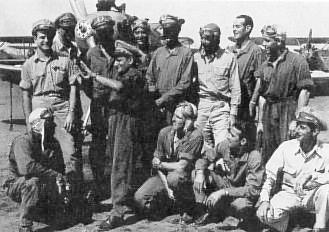
A WW2 era photo (courtesy of Rebecca Serignese, enhanced by Bill Grasha) of cadets at Morton Air Academy.
Rebecca Serignese reported that "My grandfather (James Ciampolillo) was an instructor at the Morton Air Academy during WW2.
My grandfather is the one in the center visually showing the cadets something with his hands."
"Gary, Army" was listed in the 1944 US Army/Navy Directory of Airfields (courtesy of Ken Mercer).
It was described as having a 2,800' hard-surfaced runway.

A 1944 map of Gary Field ("Blythe Primary Flying School" at the top) & its 3 auxiliary fields & other nearby airfields (courtesy of John Voss).
Gary Field had a total of 3 auxiliary airfields during WW2:
A-1 Ripley #1 (10 miles south), A-2 Ripley #2 (8 miles south), and A-4 (which was located a mere half mile to the west).
Apparently not a trace remains of Gary Field's 3 former auxiliary fields.

A 1944 diagram (courtesy of John Voss) of the airfield at Gary Field (on the right), and its auxiliary field A-4 (on the left).
As depicted on the diagram, the airfield at Gary Field consisted of a rectangular landing mat, measuring 3,000' x 2,000'.
The January 1945 AAF Airfield Directory (courtesy of Scott Murdock) described Gary Field
as a 720 acre irregularly-shaped property having an asphalt landing mat measuring 2,900' north/south by 2,700' east/west.
The field was said to have 2 wood & metal hangars, measuring 200' x 151',
and to be owned & operated by the Defense Plant Corporation.

The earliest depiction of Gary Field on an aeronautical chart which has been located
was on the August 1945 San Diego Sectional Aeronautical Chart (courtesy of Chris Kennedy), which depicted Gary as an auxiliary airfield.
The facilities of the former Morton Air Academy were reused in 1947 by the Palo Verde College,
and it was at this point that any aviation use of the airfield presumably ended.

A 7/26/48 USGS aerial view depicted Gary Field (on the right)
as well as its auxiliary field A-4 (the north/south asphalt airfield located a mere half-mile to the west).
The airfield at Gary Field was definitely closed by 1948,
as it was no longer depicted at all on the 1948 or 1949 San Diego Sectional Charts (according to Chris Kennedy).

However, Gary Field (& the Morton Air Academy) were still depicted on the 1951 USGS topo map (courtesy of Fran Blake).
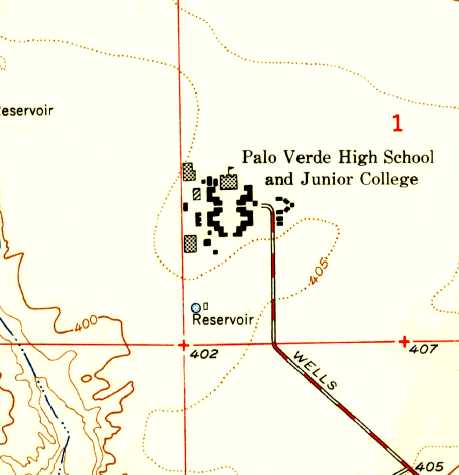
A closer-scale 1951 USGS topo map labeled the Gary Field buildings as “Palo Verde High School & Junior College”, but no longer depicted the airfield at all.

The last photo which has been located showing the facilities at Gary Field to remain completely intact was an undated aerial view looking north,
showing the facilities being reused as the Palo Verde High School, from the 1955 Palo Verde Annual (courtesy of Fred Grande, enhanced by Bill Grasha).
Fred observed, “It was taken before 1953 because when I was there, there were 15-20' tall cotton wood tree all around the parade grounds (quad) .
My sisters & I went to Gary Field (then called - Palo Verde High School). In fact I was in the last class going through – 1958.”
Palo Verde College continued to use the Gary Field facilities until 1958.
Gary Field was not depicted at all (even as an abandoned airfield) on the 1969, 1981.
Amazingly though, after being abandoned as an airfield for at least 33 years, the site of Gary Field was reused as a private airfield.
According to the FAA Airport/Facility Directory, as of 1981 the site has been registered as a private airfield, "W R Byron Airport" (44CA).
It was listed as having a single 2,640' asphalt Runway 18/36, with one single-engine aircraft based on the field.
The owner was listed as Willard R. Byron.

The 1994 USGS aerial photo showed that many of Gary Field's original hangars & buildings remained standing,
although the northern hangar had been removed at some point between 1953-94.
It did not show any indication of the use of the property as a private airfield.

Amazingly, even though Gary Field has apparently been abandoned for some 50 years,
in the 2002 USGS aerial photo, many of the original hangars & buildings remain standing.
In particular, the characteristic irregular arrangement of the barracks buildings which remains at the site
make the location of Gary Field very much recognizable.
One of the large arch-roof hangars remains standing (at the southwest corner of the group of buildings),
as well as the tower/operations building (just north of the large hangar),
as well as one smaller hangar (northeast of the tower/operations building).
The second large hangar (at the northwest corner of the site) was apparently removed, but its foundation is still clearly recognizable.
A 2,500' long portion of the former runway area remains intact, adjacent to the west side of the buildings.

A September 2004 panorama by Chris Kennedy looking northwest at the almost completely intact buildings & hangars of Gary Field.

A September 2004 photo by Chris Kennedy looking northwest at the 60-year old south hangar which remains standing at Gary Field.

A September 2004 photo by Chris Kennedy looking northwest at middle hangar at of Gary Field.
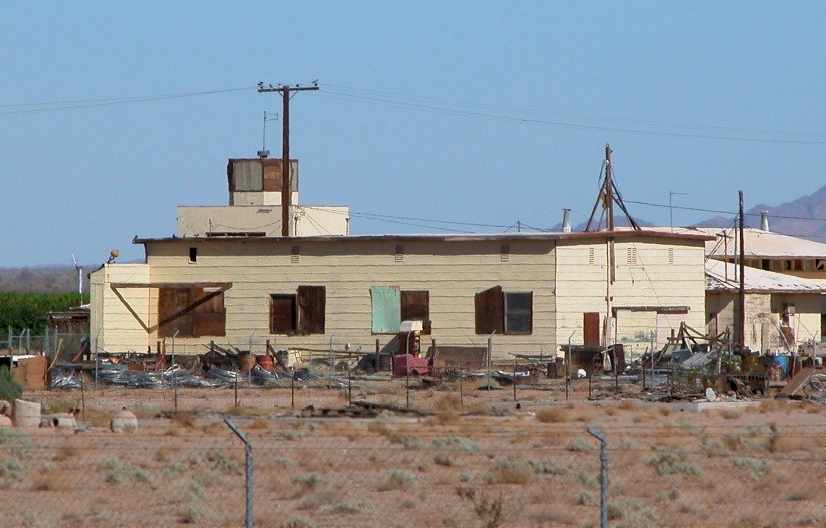
A September 2004 photo by Chris Kennedy looking northwest at the boarded-up control tower,
which remains standing on top of the former operations building.
Chris Kennedy visited the site of Gary Field in September 2004, and found that the site is remarkable well-preserved,
with most of the former airfield buildings & hangars still standing, and in quite good condition.
His report: "The Gary Field site is completely fenced off & marked 'Private' & 'No Trespassing'.
As you can see in the pictures, there are electric wires running into it & some evidence of use of some of the buildings.
I was surprised to find so much still intact."

A July 2008 aerial view by Glen Haas (of Glen Haas Aerial Photography) looking northeast at the control tower & a hangar at Gary Field.
Glen observed, “I flew over the remnants of this field & was curious as to its origins.
The design of the main terminal & the layout of the other buildings/classrooms/hangers/etc was really quite interesting.
Given that Blythe is a miserably hot, barren place (especially 50 years ago) it amazed me this place existed.
What was more amazing was the size of the place. I flew over in a 1946 Cessna 120 so it seems fitting.”

A July 2008 aerial view by Glen Haas (of Glen Haas Aerial Photography) looking east at the remains of Gary Field.
As of 2009, the FAA Airport/Facility Directory still shows the site of Gary Field
being used as a private airfield, "W R Byron Airport" (44CA).
In Keith Wood's words, "Nice to see one of the old ones get a new life."

A sad 2012 photo by Travis Waters (enhanced by Bill Grasha) of the Gary Field control tower, still standing, but with the first-floor roof caving in.
Travis reported, “The place looks pretty abandoned & torn up.”
What a shame that someone can not stabilize this evocative part of our nation's aviation heritage.

A 2012 photo by Travis Waters of the interior of a Gary Field hangar.
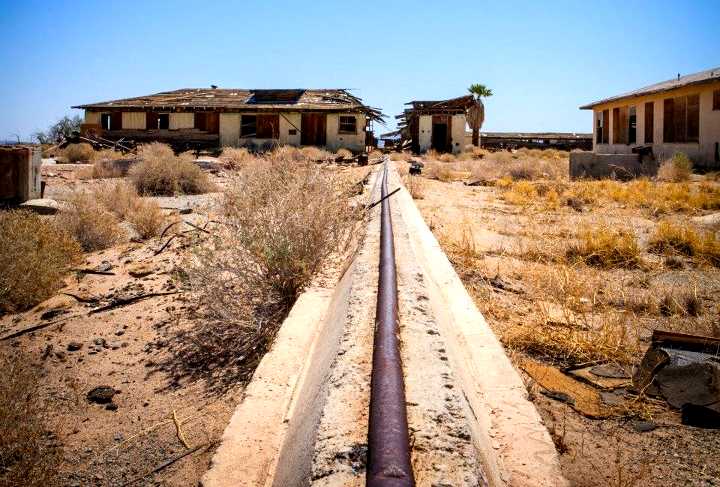
A 2012 photo by Travis Waters of what appears to be the remains of hangar door tracks at Gary Field, with something appearing to have gone straight through the building along the same axis?

A panoramic 2012 photo by Travis Waters of the hangars & other remaining buildings at Gary Field.
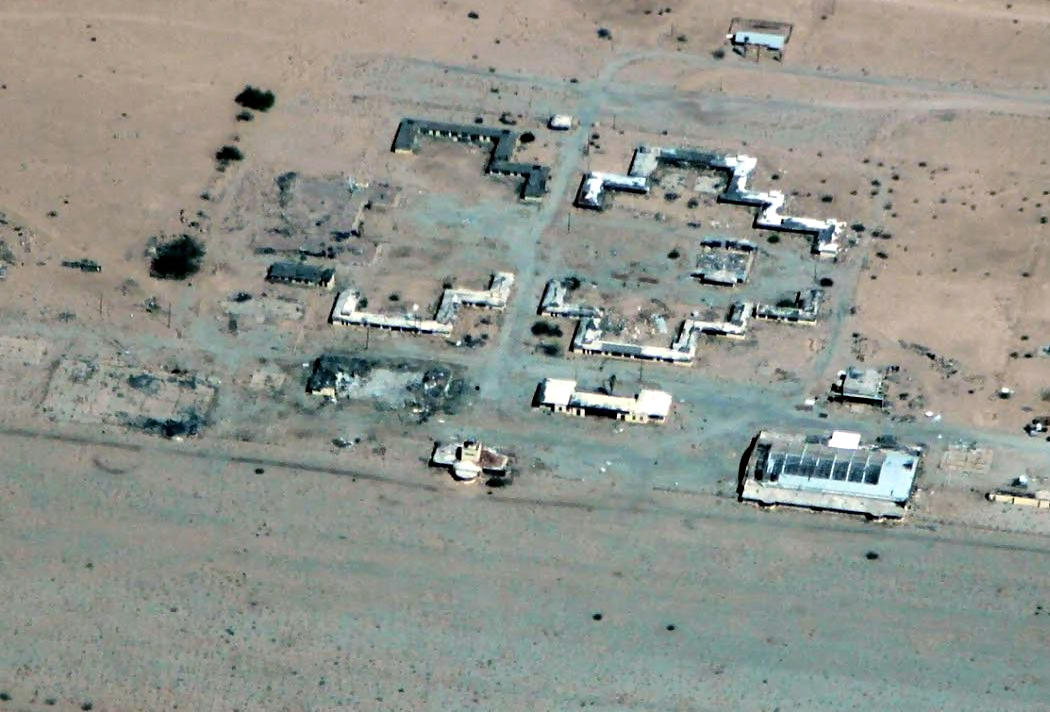
A 3/25/14 aerial view by Chris Kennedy (enhanced by Bill Grasha) looking east at the remains of Gary Field.
Unfortunately it appears the arch-roof hangar just northeast of the control tower was burned down at some point between 2012-14.
What a shame to see this collection of historic WW2 buildings disappearing.

A 5/8/14 photo by Andrea Smith (of www.arizonaspecialtyphotography.com) of the sad looking remains of the Gary Field control tower.

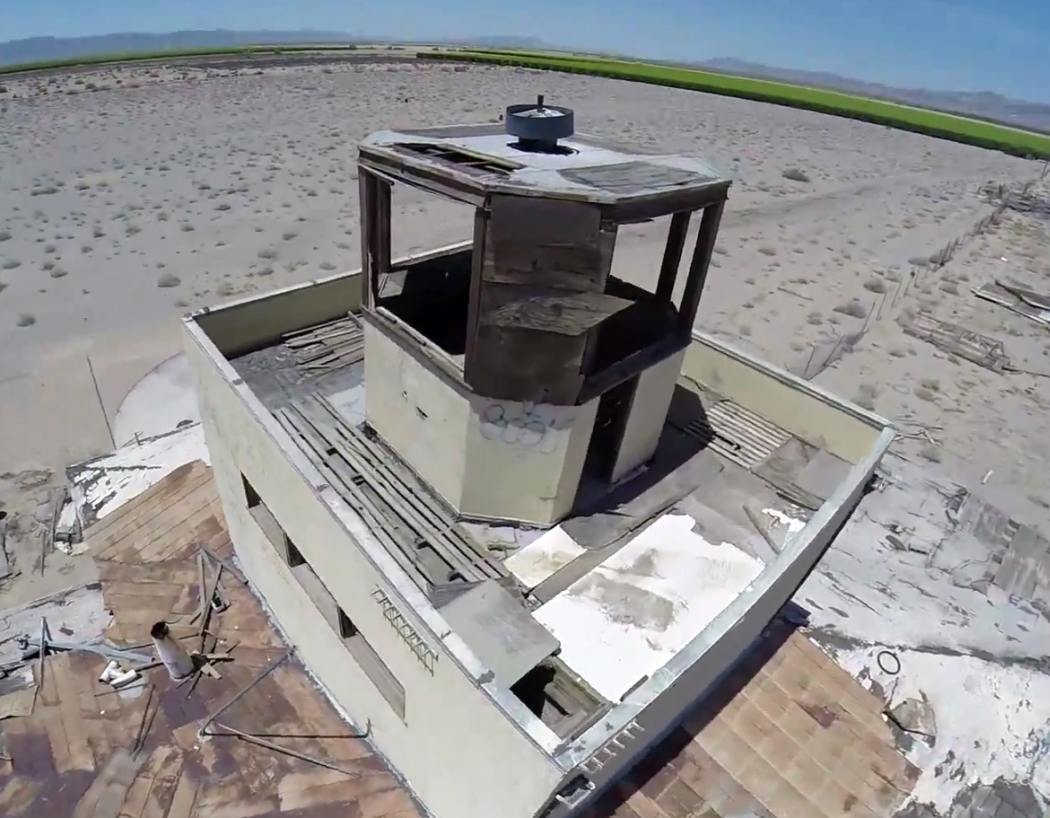
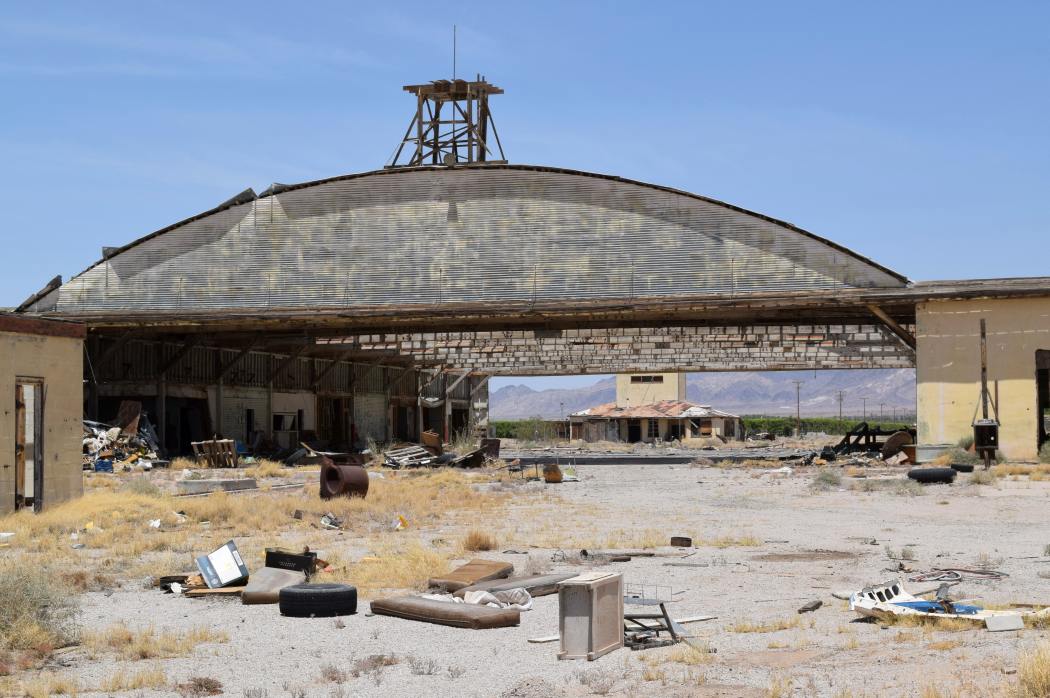
A 5/8/14 photo by Andrea Smith (of www.arizonaspecialtyphotography.com) of the sole hangar which remains standing (barely) at the site of Gary Field.

A 5/8/14 photo by Andrea Smith (of www.arizonaspecialtyphotography.com) of the exposed interior of the sole remaining hangar at the site of Gary Field.

A 5/8/14 photo by Andrea Smith (of www.arizonaspecialtyphotography.com) of an unusual remnant at the site of Gary Field –
presumably the remains of an massive underground fuel storage tank.
Andrea Smith reported in 2014, “The property has a tax liability for approximately $53,000
so whomever comes up with the back taxes will be the proud owner of this old piece of history.”

A 5/25/14 photo by Thomas Matthews (courtesy of Tyler McMillin) of a fire which tragically destroyed one of the historic Gary Field buildings.
Tyler reported, “This morning one of the buildings in the W.R. Byron Airport or the former Morton Air Academy was destroyed by a fire.
The fire was so big that it emitted a long stream of smoke.”
An article in the 6/3/14 issue of The Desert Independent (courtesy of Tyler McMillin) reported,
“On Sunday, May 25 the Blythe Police Department received numerous 911 calls at about 5:30 A.M.
regarding a structure on fire at the old Morton Air Academy (3500 block Wells Road).
The Blythe Fire Department responded & found 3 separate structures near the center of the gated property fully engulfed.
Due to the suspicious nature of the fire, Blythe Police Department investigators were called to the scene & are investigating the cause.
The 3 structures involved are over 70 years old & were a total loss.”
Tyler McMillin reported on 5/31/14, “I looked at the airport in the distance & most buildings including the big hangar are still standing.”

A 4/12/15 aerial view by John looking southeast at the remains of Gary Field,
showing that the building destroyed by the 2014 fire was one of the barracks buildings behind the flightline.
The site of Gary Field is located at the northwestern terminus of West Wells Road, 6 miles northwest of Blythe.
____________________________________________________
(Original) Desert Center Airport, Desert Center, CA
33.72, -115.39 (Northeast of Los Angeles, CA)

The original Desert Center Airport, as depicted on the February 1934 San Diego Sectional Chart (courtesy of Chris Kennedy).
Photo of the airport while open has not been located.
The original airport for the town of Desert Center was located adjacent to the northeast side of the town.
The date of constructino of the Desert Center Airport has not been determined.
The earliest reference to the field which has been located
was in the 1929 Airplane Landing Fields of the Pacific West (courtesy of Chris Kennedy).
It described Desert Center as a private field owned by S. A. Ragsdale,
which was open to the public for emergency purposes.
The field was said to consist of sandy runways measuring 4,000' east/west & 2,600' north/south.
The Airport Directory Company's 1933 Airport Directory (courtesy of Chris Kennedy) described Desert Center as a commercial airport.
It was said to be a dirt field with 2 runways in a cross shape: 4,000' east/west & 2,600' north/south.
The Desert Center Airport apparently gained lights at some point between 1933-38,
as The Airport Directory Company's 1938 Airport Directory (courtesy of Chris Kennedy)
described the field as having beacon, boundary, and approach lights.
The airfield had also changed when compared with the 1933 directory: it was now described as having 2 sod runways in an “L” shape,
measuring 3,000' east/west & 2,600' north/south.
Note: it is a little optimistic that this field in the middle of the California desert had “sod” runways!
At some point between 1938-40 the Desert Center Airport started serving as one of the Department of Commerce's network of Intermediate Fields
(located for emergency use of commercial aircraft in between major cities).
The August 1940 San Diego Sectional Chart (courtesy of Chris Kennedy) depicted Desert Center Airport as “Site 17” along the airway.
The Airport Directory Company's 1941 Airport Directory (courtesy of Chris Kennedy)
described the Desert Center Airport as the Civil Aeronautic Administration's Site 17 along the LA – Phoenix Airway.
The field was described as having 2 “gravelly sandy” runways in an “L” shape: 3,740' east/west & 2,860' north/south.
The August 1943 San Diego Sectional Chart (courtesy of Chris Kennedy)
continued to depict the original Desert Center Airport,
but it also showed that the new Desert Center Army Airfield had been established closeby to the northeast.
Desert Center Airport was described in the April 1944 US Army/Navy Directory of Airfields (courtesy of Ken Mercer)
as as being Site 17 along the Los Angeles – Phoenix Airway.
It was described as having a 3,800' unpaved runway.
The Haire Publishing Company's 1945 Airport Directory (courtesy of Chris Kennedy)
described Desert Center Airport as CAA Intermediate Field #17.
It was said to be a “class 3” airfield, privately owned but operated by the CAA.
The manager was listed as Stanley Ragsdale.
The field was described as having 2 gravel runways: 3,740' east/west & 2,860' north/south.

The last chart depiction which has been located of the original Desert Center Airport as an active airfield
was on the March 1949 San Diego Sectional Chart (courtesy of Chris Kennedy).
It depicted Desert Center Airport as having a 3,700' unpaved runway.
The Desert Center Airport was evidently abandoned at some point between 1949-51,
as it was no longer depicted at all on the March 1951 San Diego Sectional Chart (courtesy of Chris Kennedy).

The 2 runways of Desert Center Airport were still depicted on a 1954 AAA map of Riverside County (courtesy of Chris Kennedy),
but it was labeled simply as “Landing Field”,
which most likely indicates that it was no longer an active airport by that point.
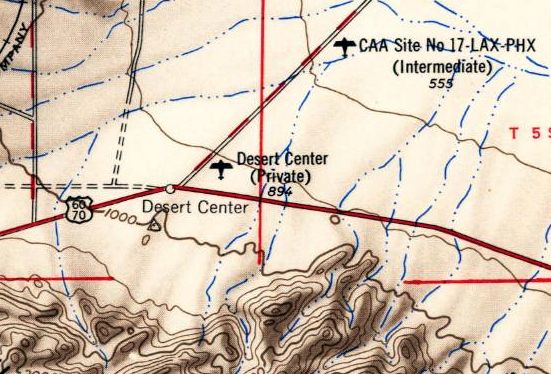
The 1954 USGS topo map depicted Desert Center as a private airfield.
The Desert Center Airport was no longer depicted at all on the 1963 USGS topo map.

In the 2002 USGS aerial photo, the outline of almost all of the former north/south runway was still intact.
The outline of the east/west runway was also still somewhat recognizable, although it had been built upon.

A 2006 aerial photo by Joe Merkert (enhanced by Bill Grasha) looking northeast at the original Desert Center Airport,
showing “the wrecked car storage facility on the southern runway with the north/south runway still clear.”
The Desert Center Airport is located northwest of the intersection of Route 177 & Ragsdale Road.
____________________________________________________
Since this site was first put on the web in 1999, its popularity has grown tremendously.
That has caused it to often exceed bandwidth limitations
set by the company which I pay to host it on the web.
If the total quantity of material on this site is to continue to grow,
it will require ever-increasing funding to pay its expenses.
Therefore, I request financial contributions from site visitors,
to help defray the increasing costs of the site
and ensure that it continues to be available & to grow.
What would you pay for a good aviation magazine, or a good aviation book?
Please consider a donation of an equivalent amount, at the least.
This site is not supported by commercial advertising –
it is purely supported by donations.
If you enjoy the site, and would like to make a financial contribution,
you
may use a credit card via
![]() ,
using one of 2 methods:
,
using one of 2 methods:
To make a one-time donation of an amount of your choice:
Or you can sign up for a $10 monthly subscription to help support the site on an ongoing basis:
Or if you prefer to contact me directly concerning a contribution (for a mailing address to send a check),
please contact me at: paulandterryfreeman@gmail.com
If you enjoy this web site, please support it with a financial contribution.
This site covers airfields in all 50 states.